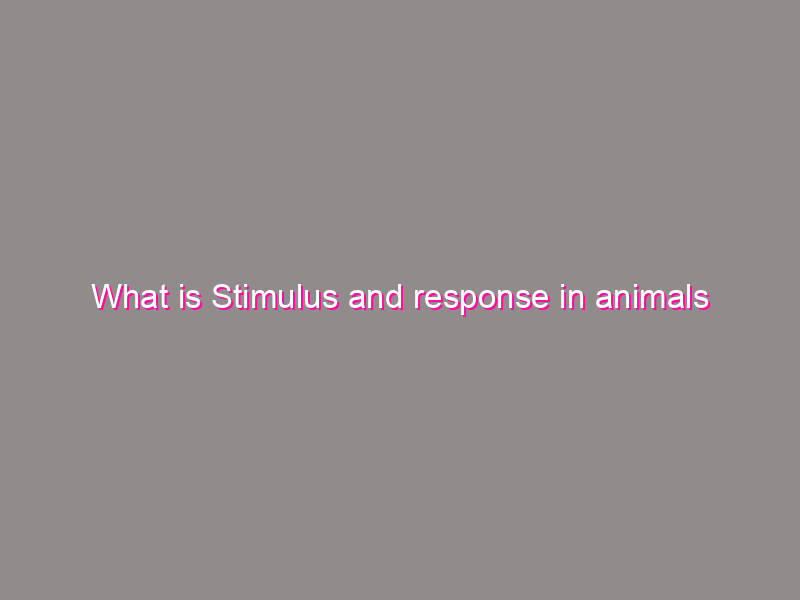
Stimulus and response are two important concepts in the study of animal behavior. Stimulus and response play a role in showing animal adaptation and evolution.
Animals that have effective responses to stimuli are better able to cope with the environment around them and are better equipped to deal with predators or find food. Animals that have effective responses to stimuli are better able to carry out their biological goals, such as reproduction and saving their young.
What’s that
Stimulus and response are two very important concepts in evolutionary biology, specifically in the study of animals. A stimulus is a change in the environment around an animal that produces sensory impulses in the organism. A response is a reaction given by an animal to a stimulus.
Stimuli can include sound, aroma, light, temperature and pressure. Examples of stimuli are the sound of birds, the smell of fruit, sunlight, hot temperatures, and air pressure. Stimuli can influence animal behavior and physiology.
A response is a reaction given by an animal to a stimulus. Responses can be physical behavior (such as searching for food or avoiding predators), physiological behavior (such as controlling body temperature), or emotional behavior (such as inciting or comforting). Responses can also influence animal behavior and physiology.
Stimulus:
A stimulus is anything that can stimulate or trigger a response from an animal. Stimuli can be physical signals, such as light, sound, or touch, or chemical signals, such as smell or taste. Stimuli can also come from the animal’s external or internal environment, such as changes in temperature or a state of starvation.
Response:
A response is an action or reaction carried out by an animal in response to the stimulus received. Responses can include physical movements, such as moving or dodging, behavioral changes, such as communicating with sounds or changing body color, or physiological changes, such as changing heart rate or releasing hormones.
Example:
For example, if a bird sees prey moving in front of it (a visual stimulus), it may respond by flying and catching the prey (a motor response). Or, if a cat smells delicious food (a chemical stimulus), it may respond by licking its lips or running toward the food (a behavioral response).
Stimulus and response are interrelated and important in understanding how animals interact with their environment. An animal’s response to a stimulus can vary depending on the species, situation, and individual experience. The study of stimulus and response helps us understand how the nervous system works, animal perception, and the behavioral adaptations that may occur in various situations.
FAQs about Stimulus and Response
What is a stimulus?
A stimulus is any external or internal change in the environment that triggers a response in an organism. Stimuli can be diverse, including physical factors such as light, temperature, sound, or touch, as well as chemical signals, changes in pH, or the presence of specific molecules.
What is a response?
A response is a specific reaction or behavior exhibited by an organism in reaction to a stimulus. It is the organism’s way of adjusting its physiological or behavioral state to adapt to or interact with its environment. Responses can range from simple reflexes, such as pulling away from a hot surface, to complex behaviors like migration or learning.
What are the different types of responses?
There are various types of responses that organisms can exhibit:
- Reflex responses: These are automatic, involuntary responses that occur rapidly and without conscious thought. For example, blinking when exposed to a sudden bright light or jerking your hand away from a sharp object.
- Taxis and kinesis: Taxis refers to directed movement toward or away from a stimulus, such as an organism swimming toward light (positive phototaxis) or moving away from a noxious chemical (negative chemotaxis). Kinesis, on the other hand, is a non-directional, random change in an organism’s activity level in response to a stimulus.
- Behavioral responses: These are complex actions or movements that organisms perform in response to stimuli. Examples include mating displays, nest building, or foraging behaviors.
- Physiological responses: These involve changes in the internal physiological state of an organism in response to a stimulus. For instance, increasing heart rate and blood flow during physical exertion or releasing stress hormones in response to a threatening situation.
How do organisms detect and process stimuli?
Organisms have specialized sensory organs or structures that allow them to detect and process stimuli. These can include sensory receptors such as eyes, ears, nose, taste buds, touch receptors, and chemoreceptors. When a stimulus is detected, sensory information is transmitted to the central nervous system, where it is processed and integrated. The brain or nervous system then generates appropriate responses through nerve impulses.
Can organisms exhibit learned responses?
Yes, organisms can exhibit learned responses through a process known as conditioning. This involves associating a specific stimulus with a particular response. There are two main types of conditioning:
- Classical conditioning: This occurs when an organism learns to associate a neutral stimulus with a meaningful stimulus, resulting in a conditioned response. Ivan Pavlov’s famous experiments with dogs, where he conditioned them to salivate at the sound of a bell, are an example of classical conditioning.
- Operant conditioning: In this type of learning, an organism learns to associate its behaviors with certain consequences, either reinforcing or punishing. Through trial and error, the organism adjusts its behavior to maximize rewards and minimize punishments.
Can stimuli and responses vary among different organisms?
Yes, stimuli and responses can vary among different organisms based on their evolutionary adaptations and ecological niches. Different organisms have different sensory capabilities, allowing them to detect and respond to specific stimuli relevant to their survival and reproduction. Additionally, the complexity and range of responses can vary greatly, from simple reflexes in single-celled organisms to intricate behaviors and cognitive processes in more complex organisms like mammals.